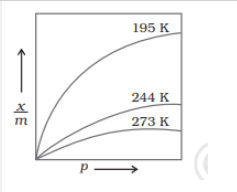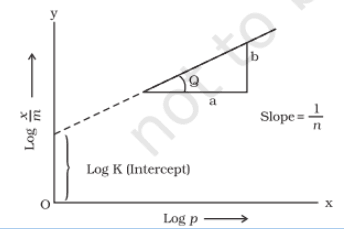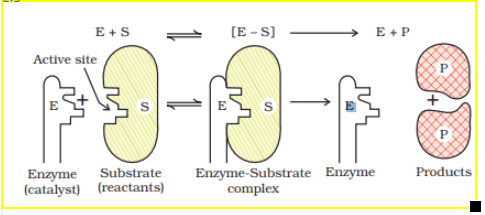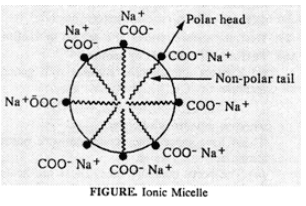Chemistry Ncert Solution Class 12 Chapter 5
NCERT solutions for Class 12 Chemistry Chapter 5 Surface Chemistry - In this chapter, some important topics of surface chemistry will be discussed. These topics include catalysis, adsorption and collisions which also involves emulsions and gels. NCERT solutions for class 12 chemistry chapter 5 Surface Chemistry emphasises on answers with the help of a phenomena that occur at the surfaces or interfaces. This chapter carries 4 marks in the CBSE Board exams. The NCERT solutions for class 12 chemistry chapter 5 Surface chemistry are prepared by chemistry experts and presented in a step-by-step manner. These solutions will help you in the board exam preparation as well as in the competitive exams. By referring to the NCERT solutions for class 12, students can understand all the important concepts and practice questions well. Read further to know more about NCERT solutions for Class 12 Chemistry Chapter 5 PDF download.

Topics and Sub-topics of NCERT class 12 chemistry chapter 5 Surface Chemistry-
5.1 Adsorption
5.2 Catalysis
5.3 Colloids
5.4 Classification of Colloids
5.5 Emulsions
5.6 Colloids Around Us
Find NCERT solutions for class 12 chemistry chapter 5 Surface Chemistry below:
Solutions to In Text Questions Ex 5.1 to 5.8
Question 5.1 Write any two characteristics of Chemisorption.
Answer :
Two characteristics of Chemisorption-
- The bond formation between the solid(adsorbent) and the gas molecules is by chemical bonds like a covalent bond or ionic bond.
- It is highly specific in nature and also irreversible.
Question 5.6 What is the role of desorption in the process of catalysis?
Answer :
In catalytic reaction, the reactant attached on the surface of the catalyst and form complex and after some procedure, it becomes the product of the reaction. We need to detach it from the surface of the catalyst to get the product and catalyst separately and hereby desorption process, we can get the product.
Question 5.7 What modification can you suggest in the Hardy Schulze law?
Answer :
According to Hardy-Schulze law that 'the higher the valence of the flocculating ion added, the higher is its power to cause precipitation. Here he does not about the size of the ion, which polarises the other oppositely charged ion. Hence the modified law should be "the greater the polarising power of flocculating ion added, the greater is its power to cause precipitation."
Question 5.8 Why is it essential to wash the precipitate with water before estimating it quantitatively?
Answer :
The precipitate is formed from reactions so it contains some chemical or unwanted substances traces (like impurities, catalyst and reactant). For quantitative estimation of the product, we need to remove these additional substances which get adsorbed onto the surface of the required product and it gives us the wrong information about the product of the reaction. So to avoid this problem we wash the precipitate with the water (most of the impurities are water soluble).
NCERT Solutions for Class 12 Chemistry Chapter 5 Surface Chemistry Exercises
Question 5.1 Distinguish between the meaning of term adsorption and absorption. Give one example of each.
Answer :
Adsorption- It is a surface phenomenon in which the molecules or substances accumulate at the surface rather than in a bulk of a solid or liquid. The substance that gets adsorbed is called adsorbate and the material on which it is adsorbed is called adsorbent. In adsorption, the adsorbate does not penetrate the adsorbent surface it concentrates only at the surface of the solid and liquid. example-when we dip a chalk stick into the ink solution, only its surface becomes coloured. If we break the chalk stick, it will be found to be white from inside.
Absorption- It is a bulk phenomenon, in this process, the substance uniformly distributed throughout the bulk of the solid or liquid.example-Water vapours are absorbed by anhydrous calcium chloride.
Question : 5.2 What is the difference between physisorption and chemisorption?
Answer :
Difference between physisorption and Chemisorption-
| Physisorption | Chemisorption |
| 1. Happens due to van der Waal forces. 2. It's not specific in nature and reversible in nature. 3. It depends on the nature of the gas. More liquefiable gas is adsorbed easily. 4. enthalpy of adsorption is low around 20-40 kJ/mol 5. Low temperature required 6. It depends on the surface area. Higher the area high in the process rate. 7. Results in multimolecular layers on the adsorbent surface. | 1. Caused by a chemical bond 2. highly specific in nature and irreversible. 3. depend on the nature of the gas. those gases can react with the adsorbent show chemisorption. 4. Enthalpy if adsorption is high around 80-240 kJ/mol 5. High temperature is required. 6. High activation energy is needed sometimes 7. result is unimolecular |
Question 5.3 Give reason why a finely divided substance is more effective as an adsorbent.
Answer :
We know that adsorption is a surface phenomenon. The extent of adsorption depends on the surface area. So, Adsorption is directly proportional to the surface area of the adsorbent. More the surface area more is the amount of adsorbent adsorbed. So, therefore finely divided substance is more effective as an adsorbent due to its high surface area.
Question 5.5 What is an adsorption isotherm? Describe Freundlich adsorption isotherm.
Answer :
The adsorption isotherm is a relation curve between the variation in the amount of gas adsorbed by the adsorbent with pressure at a constant temperature.

![]()
Fig:- Adsorption isotherm
Freundlich adsorption isotherm- Freundlich gave an empirical relationship between the quantity of gas adsorbed by a unit mass of solid (adsorbent) and pressure (at a particular temperature).
On taking log both sides-

![]()
Question 5.6 What do you understand by activation of adsorbent? How is it achieved?
Answer :
by activation of adsorbent, it means increasing the adsorbing power of adsorbent. We can do it by following ways-
- By increasing the surface area of the adsorbent by cutting adsorbent into small pieces or powdering it.
- Some treatment can be also done to the adsorbent so that its power gets increased. example- charcoal is activated by heating it between 650 K and 1330 K in vacuum or air
Question 5.7 What role does adsorption play in heterogeneous catalysis?
Answer :
Those catalytic process in which the reactant and catalyst are in a different phase is known as heterogeneous catalysis.
Role of adsorption in heterogeneous catalysis-
- Diffusion of reactants to the surface of the catalyst.
- Adsorption of reactant is on the surface of the catalyst.
- The chemical reaction can occur at the catalyst surface by intermediate formation between them.
- Desorption of the product of the reaction is also at the surface of the catalyst.
Question 5.9 How are the colloidal solutions classified on the basis of physical states of the dispersed phase and dispersion medium?
Answer :
First criteria for classifying the colloids is the physical state of the dispersed phase and a dispersion medium. Depending upon whether the dispersed phase and the dispersion medium are solids, liquids or gases, there are eight types of colloidal systems -
| Dispersed phase | Dispersion medium | Type of colloid | Examples |
| solid | solid | solid sol | some coloured gases and gemstones |
| solid | liquid | sol | Paints, cell fluids |
| solid | gas | aerosol | Smoke, dust |
| liquid | solid | gel | Cheese, jellies |
| liquid | liquid | emulsion | Milk, hair cream, butter |
| liquid | gas | aerosol | fog, mist, cloud, insecticide sprays |
| gas | solid | solid sol | pumice stone, foam rubber |
| gas | liquid | foam | froth, whipped cream, soap lather |
Question 5.10 Discuss the effect of pressure and temperature on the adsorption of gases on solids.
Answer :
Effect of temperature and pressure on the adsorption of gases on solids-
Temperature- According to Le-Chatelier's principle the physical adsorption readily occurs at low temperature and adsorption rate is slow at high temperature.
Pressure- As we increase the pressure the amount of gas adsorbed on adsorbent is increased as the volume of gas decreases. Since it is an exothermic process, the physical adsorption occurs fast at low temperature and decrease with increase in pressure.
Question 5.11 What are lyophilic and lyophobic sols? Give one example of each type. Why are hydrophobic sols easily coagulated ?
Answer :
(i) Lyophilic sols- These sols are solvent loving. In these types of sols, the dispersed phase has an affinity towards the dispersion medium(liquid).example- starch, gum and protein . The affinity is due to the ability to form a hydrogen bond with the dispersion medium(water) These sols are reversible in nature.
(ii) Lyophobic sols- These are water-hating. In these types of sols, the dispersed phase has no affinity towards the dispersion medium or the solvent. example- metals, their sulphides etc. on simply mixing they do not form colloidal solution. Their colloidal sols can be prepared only by some special methods. sol particles have some positive or negative charges. Irreversible in nature.
Question 5.12 What is the difference between multimolecular and macromolecular colloids? Give one example of each. How are associated colloids different from these two types of colloids?
Answer :
Multimolecular colloids - On dissolution, a large number of atoms or smaller molecules aggregate together to form species of size 1-1000 nm of colloidal range. This species termed as multimolecular collides. Example- gold sol and sulphur sol.
Macro-molecular colloids- In suitable solvents, they form solutions in which the size of the macromolecules may or may not be in the colloidal range. Such systems are called macromolecular colloids. Examples- starch, protein and cellulose.
Associated colloids- those substances, which behaves like normal strong electrolyte at low concentration, but exhibits colloidal behaviour at high concentration due to the formation of aggregates. And these are known as associated colloids also called micelle.
Question 5.13 What are enzymes ? Write in brief the mechanism of enzyme catalysis.
Answer :
Enzymes are that substance which is produced by living plants and animals. These are the complex nitrogenous organic compound. Actually, it is a protein molecule of high molecular weight and forms colloidal solution on dissolving in water.
Brief mechanism of enzyme catalysis-
On the surface of enzymes, active centres are present of different shape and size and possess active groups like etc. The substrate which has complementary shape, attach into these active sites just like a key fits into a lock. As a result, an active complex formed, later on, which becomes a product.
step 1. Binding of an enzyme to the substrate to form complex ( )
step 2.To product formation, decomposition of the activated complex ( )

![]()
Question 5.14(i) How are colloids classified on the basis of
(i) physical states of components.
Answer :
There are eight types of colloids whether the components are solids, liquids or gas. Here components mean dispersed phase and a dispersion medium.
| Dispersed phase | Dispersion medium | Type of colloid |
| solid | solid | solid sol |
| solid | liquid | sol |
| solid | gas | aerosol |
| liquid | solid | gel |
| liquid | liquid | emulsion |
| liquid | gas | aerosol |
| gas | solid | solid sol |
| gas | liquid | foam |
Question 5.16 What are emulsions? What are their different types? Give example of each type.
Answer :
The colloidal solution in which both the dispersed phase and dispersion medium are liquid in nature are called emulsions.
There are two types of emulsions-
(i) oil in water (O/W) -Oil is dispersed phase and water is dispersion medium (milk)
(ii) water in oil (W/O) - Water is the dispersed phase and oil is dispersion medium (cold cream, butter etc.)
Question 5.17 How do emulsifiers stabilise emulsion? Name two emulsifiers.
Answer :
The emulsifying agents are also known as emulsifiers. For stabilisation of emulsion, they form an interfacial film between suspended particles and medium.
Example- for O/W gums, natural and synthetic soaps for W/O heavy salts of fatty acids, long chain alcohols
Question 5.18 Action of soap is due to emulsification and micelle formation. Comment.
Answer :
The cleansing action of soap is because of emulsification and micelle formation. Soaps are sodium or potassium salts of long chain fatty acids, represented as (e.g. sodium stearate
). when dissolved into the water it dissociates into
and
ions.
. The long carbon chains are non-polar in nature (hydrophobic) and
are polar in nature (hydrophilic part).
When the soap is added to dirt containing water. The soap molecules surround the dirt particle where the hydrophobic part is attached to dirt and the hydrophilic part is pointing away from the dirt. This is called micelle formation. Therefore we can say that the non-polar part dissolved in dirt particle and the polar group dissolved in water. Now, as these micelles are negatively charged, they do not coalesce and a stable emulsion is formed.

![]()
Question 5.19 Give four examples of heterogeneous catalysis.
Answer :
Four examples of heterogeneous catalysis-
1. oxidation of sulphur dioxide into sulphur trioxide in the presence of Pt.
2. the combination between dinitrogen and dihydrogen to form ammonia
3. Hydrogenation of vegetable oils in the presence of Ni as a catalyst
4. Ostwald Process - oxidation of ammonia into nitric acid in the presence of Pt
Question 5.20 What do you mean by activity and selectivity of catalysts?
Answer :
(i)The activity of the catalyst is to increase the rate of a particular reaction. It depends on the strength of chemisorption to a large extent. Adsorption of reactants should be neither too high nor too weak. It should just be optimum so that the catalyst is staying active.
(ii)The selectivity of catalyst is the ability to direct the reaction to give a particular product when under the same reaction condition the products are possible also.
Example- Reaction between CO and
Question 5.21 Describe some features of catalysis by zeolites.
Answer :
Zeolites are good shape selective catalyst due to their honeycomb-like structures. They are alumino-silicates that are microporous in structures. They are the 3D network of silicates in which some atoms of silicon are replaced by aluminium giving framework. Size and shape of reactant and product molecules, as well as pores and cavities of zeolites, are the reaction determining factors in zeolites.
Question 5.22 What is shape selective catalysis?
Answer :
Shape-selective catalysis, in which the reaction mainly depends on the size of the reactants and product molecules and also the pore structure of the catalyst.
Ex. zeolites are good shape selective catalyst.
Question 5.23(i) Explain the following terms:
(i) Electrophoresis
Answer :
Electrophoresis-
The movement of colloidal particles under the influence of electric current is known as electrophoresis. The negatively charged particles move towards the cathode and positive charge particles move towards the anode.
Question 5.23(iii) Explain the following terms:
(iii) Dialysis
Answer :
Dialysis- The process of removing a dissolved substance from the colloidal solution by means of diffusion through a suitable membrane. The principle behind this is small molecules and ions can pass through the animal membrane.
Question 5.23(iv) Explain the following terms:
(iv) Tyndall effect
Answer :
Tyndall effect - When a beam of light is passed through the colloidal solution the colloidal particles scatter the light and make the beam visible in colloidal solution. This effect is observed by Faraday and later on detail in studied by Tyndall and is known as the Tyndall effect.
Question 5.24 Give four uses of emulsions.
Answer :
Four use of emulsions-
- The cleansing action of soap
- to make medicins by emulsification process
- Digestion of fats in the intestine
- Antiseptic and disinfectant when adding to water form emulsion.
Question 5.25 What are micelles? Give an example of a micelles system.
Answer :
When the long chain of fatty acids like soap and detergent is added to water the hydrophobic part of their chain is aligned towards the centre in such a manner that they form a spherical shape and their hydrophilic part is facing towards outside. This spherical like structure is known as a micelle. 
![]()
Structure of sodium soap(Left side - hydrophobic part, Right side- hydrophilic part)

![]() fig:- Micelle of that sodium soap.
fig:- Micelle of that sodium soap.
Question 5.26(i) Explain the terms with suitable examples:
(i) Alcosol
Answer :
Alcosol- A solution in which the dispersion medium is alcohol and the dispersed phase is a solid substance. examples- colloidal sol of cellulose nitrate in ethyl alcohol is an alcosol.
Topics and Sub-topics of NCERT class 12 chemistry chapter 5 Surface Chemistry-
5.1 Adsorption
5.2 Catalysis
5.3 Colloids
5.4 Classification of Colloids
5.5 Emulsions
5.6 Colloids Around Us
NCERT solutions for Class 12 Chemistry
NCERT solutions for class 12 subject wise
Benefits of NCERT solutions for class 12 chemistry chapter 5 Surface Chemistry
-
The detailed answers given in the Class 12 Chemistry Chapter 5 NCERT solutions will help the students to understand the chapter easily.
-
Referring to the NCERT solutions for Class 12 Chemistry Chapter 5 Surface Chemistry will make revision easier and match the answers for better conceptual understanding.
-
Homework will be easy with NCERT Class 12 Chemistry solutions chapter 5, all students will need to do is check the CBSE NCERT solutions for 12 Class chemistry chapter 5 and get reassured about the answers.
Solutions
Frequently Asked Question (FAQs) - NCERT solutions for Class 12 Chemistry Chapter 5 Surface Chemistry
Question: Where can I find complete solutions for NCERT class 12 Chemistry?
Question: What are the important topics of this chapter?
Answer:
-
Basics of Adsorption and its types
-
Surface Phenomenon
-
Difference between Adsorption and Absorption
-
Chemisorption and Physisorption
-
Adsorption Isotherm - Freundlich isotherm
-
Catalysis
-
Colloids
-
Emulsions
Question: What is the weightage of NCERT class 12 Chemistry chapter 5 in CBSE board exam ?
Question: What is the weightage of NCERT class 12 Chemistry chapter 5 in JEE mains ?
Latest Articles
Explore Popular Degree, Branches and Courses
NCERT solutions for Class 12 Chemistry Chapter 5 Surface Chemistry
Chemistry Ncert Solution Class 12 Chapter 5
Source: https://school.careers360.com/ncert/ncert-solutions-class-12-chemistry-chapter-5-surface-chemistry